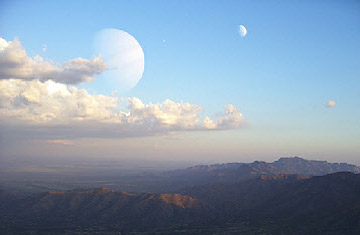
An artist's impression of a hypothetical exomoon in orbit around a planet in another planetary system
The universe seems almost infinitely reductive: our galaxy rotates around a central hub, planets orbit their planet stars, moons orbit their parent planets, and the odd moonlet may even orbit a moon.
Almost from the moment astronomers began finding planets around distant stars, they thus began talking about the moons that might orbit those alien worlds. It wasn't that they had any hope of discovering something as tiny as a moon: the smallest things they could find at the time were giant planets like Jupiter. But if a Jupiter happened to orbit in its star's Goldilocks Zone, where temperatures were relatively balmy, and if that Jupiter happened to have a moon about the size of Earth — not impossible, surely — then that hypothetical moon might have a chance of harboring life. That's a lot of ifs, which made talk of so-called exomoons seem like more of a marketing gimmick designed to gin up public interest in exoplanet science than a serious area of research.
Not any more, though. Thanks to the exquisite precision of the orbiting Kepler space telescope, the prospect of finding exomoons has finally come within reach and the search is now officially on. Speaking at this week's American Astronomical Society meeting in Austin, Harvard astrophysicist David Kipping announced a new project called the Hunt for Exomoons with Kepler, or HEK. "We actually have no idea how common moons are in other planetary systems," says Kipping — but we could be on the verge of finding out.
Kipping had started thinking about exomoons even before Kepler was launched in 2009. "It was my entire Ph.D., more or less, at University College, London," he says. He was originally thinking about transits — the passage of a planet in front of its star, which is just what Kepler was designed to look for as a sign that the planet exists at all. In particular, Kipping was wondering about what might make a transit last longer or shorter than you might expect. "It dawned on me," he recalls, "that if a planet had a moon, that could cause a speedup or a slowdown."
The reason: if a moon happens to be leading the planet as it passes by, it will pull the planet across the face of the star a little faster than average. If it happens to be following, it will hold the planet back. Not only that; whether the moon is leading or trailing, the silhouette of the planet and moon will be wider than that of a planet alone — the planet-moon system will block more of the star's light. If the moon is directly in between the planet and the gaze of Kepler, on the other hand, or if it's between the planet and the star, more starlight will reach Kepler's sensors — and the moon itself will not be visible.
For these reasons, astronomers need to see the planet pass around the star several times so that the changes in speed caused by a moon can be compared with an average speed, and so that moons that are completely hidden on one pass can have a chance to show themselves on the next. That takes time, which is why Kepler scientists need patience, but it's worth the wait.
"By combining all this," says Kipping, "you can infer a lot. You can directly measure the mass of the star, planet and moon." That's crucial, because while Kepler can gauge the size of a planet (or a planet-size moon) by how much light it blocks, the space telescope can't judge the object's mass — which, in turn, makes it possible to calculate its density. Without that information, you can't figure out what it's made of — and that's critical. Planets or moons made mostly of gas will not have the same likelihood of supporting life as those made mostly of water or rock or a mix of all three. The gravitational pull or drag of a moon on its parent planet adds a critical clue to gravity — which in turn adds further clues to mass and composition.
While the HEK project has just been formally announced, it's actually been going on for some time. "We've already got some two dozen candidate signals," says Kipping. These were all culled from from Kepler's public database — many of them by amateur sleuths who frequent a website called planethunters.org. "These guys have incredible patience, incredible skill," says Kipping. "They've become experts at finding signals amidst the noise — some of the best in the world."
One of the very best, says Kipping, is Allan Schmitt, a retired software engineer formally credited as a co-author on the scientific paper announcing HEK, and listed as "Citizen Science/Planet Hunter." Of the four most promising signals the team is looking into says Kipping, Schmidt found three. "He's a fantastic contributor."
Kipping had been hoping to present an actual discovery at this week's astronomy conference, but, he says, "we've hit a wall. We can't really confirm any discoveries, but there are some we can't rule out." As it happens, though, the Kepler mission released a flood of new observations just as the conference was getting under way. Armed with that extra data, the HEK team should be able to say something definitive, maybe within months.
"It's a really fun time for me," says Kipping, "because I've been working on the theory of moon detection for such a long time. The last few months have been the most exhilarating time of my career." The next few should be even better.
